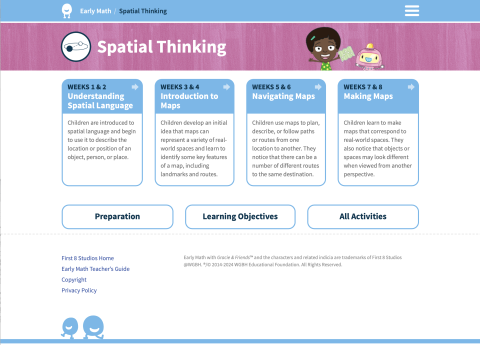Body
Image

Preschoolers’ Spatial Orientation Learning
This project provides direct student learning opportunities to foster preschoolers’ spatial learning and STEM identity, particularly for underrepresented and underserved groups, by developing and researching a preschool mathematics curriculum supplement that leverages digital touch-screen tablets and Augmented Reality technologies. Spatial thinking, which includes spatial orientation, is often ignored in formal education settings during the early years. This is a significant curricular limitation, given that recent evidence links spatial thinking to readiness for kindergarten, readiness in mathematics, and it “may create a cascade of effects” on later mathematics skills. To help start this upward cascade, our team developed and tested a preschool classroom module and connected family resources that include hands-on activities, an existing tablet-based individual game, and an Augmented Reality app based on spatial orientation learning goals. The intervention included a Teacher’s Guide to support educators and Family Guide to support caregivers in implementing in school and home environments. Our project used a a design-based research approach, to iteratively develop and test the intervention directly with preschool children (4-5-year-olds) from predominantly low-income and underserved backgrounds. These studies measured cognitive (e.g., spatial orientation learning) and social (STEM Identities) outcomes from an intervention that leverages “cutting-edge” AR technology in both f
Pillar 1: Innovative Use of Technologies in Learning and Teaching
Augmented Reality (AR) integrates the real world with virtual content that is student-centered and playfully interactive. The project developed and tested an intervention that includes: a new AR app and an existing tablet game, spatial orientation activities for preschool classrooms that integrate learning opportunities with the apps, hands-on activities, and books; a digital teacher’s guide and professional development resources; and a family guide for caregivers to foster preschoolers’ spatial learning at home.
Pillar 2: Partnerships for Career and Workforce Preparation.
Research suggests that children naturally begin developing spatial skills by preschool, yet spatial skills receive minimal curricular focus and there is a dearth of relevant classroom and home activities for this age group. Well-designed early learning experiences are thus ripe opportunities to cultivate children’s emerging spatial skills and AR is a novel approach therein. The broader goals are to improve spatial skills that prepare preschoolers for mathematics in K-12 schooling and engagement in STEM careers.
Pillar 3: Strategies for Equity in STEM Education
There is growing consensus that high-quality STEM education is critical for young children, particularly as a way to promote equity (Clements et al., 2020). Our innovative approach seeks to build on the research that preschool mathematics knowledge is a strong predictor of children’s later academic success, that spatial learning has a unique contribution to make in later STEM engagement, and that developmentally appropriate preschool mathematics experiences hold exceptional promise to address educational inequities.

Discipline(s)
Mathematical sciences
Target Gradespan(s)
Early Childhood (PK)
Target Participant(s)
Youth / students
Educators
Parents / caregivers / families
Project Setting(s)
Formal Education
Informal Education
Category
Developing and Testing Innovations (DTI)